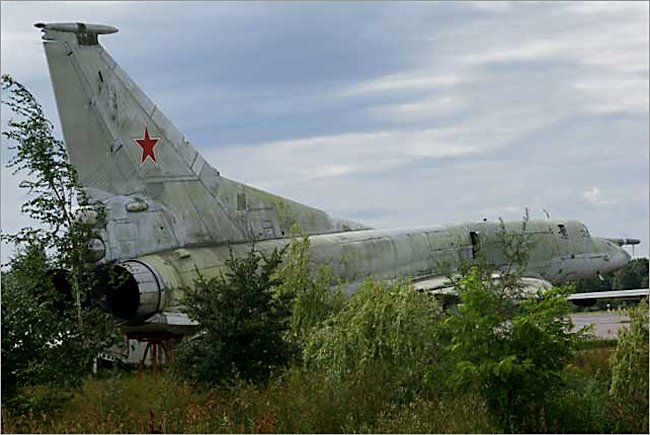Tupolev Tu-22 M1 Backfire Bomber
The famous Russian Back fire bomber RAF equivalent was the Vulcan Bomber. The Tupolev Tu-22M could go on high altitude bombing missions as well as ground hugging under radar attacks. The Tupolev Tu-22M was capable of delivering a Nuclear payload. It had a crew of 4; pilot, co-pilot, navigator and weapon systems operator. It had a maximum speed of Mach 1.88 (1,240 mph 2,000 km/h). It had a radius of 1,500 miles (2,410 km with a normal weapons load. It could fly up at 43,600 ft (13,300m) It had one 23mm GSh-23 cannon in remotely controlled tail turret. It was this weapon that gave this Russian bomber the NATO name Backfire Bomber.
There are hard points under the wings and fuselage. It could carry three Raduga Kh-22 (Russian: Х-22; AS-4 'Kitchen') large, long-range anti-ship missile developed by the Soviet Union. It was intended for use against US Navy aircraft carriers and carrier battle groups, typically with a nuclear warhead. The missile is considered a very powerful weapon, even when armed with a conventional warhead.

Photograph taken at the Russian Aircraft Museum next to Riga International Airport Latvia
The Tupolev Tu-22M Backfire bomber could also carry Six missiles on a MKU-6-1 rotary launcher in its bomb bay, plus four missiles on two underwing pylons for a total of ten missiles per aircraft. The bomb bay could also hold bombs. Sixty nine FAB-250 freefall bombs or eight FAB-1500 bombs.
The Soviet Cold War Tupolev Tu-22M (NATO reporting name 'Backfire' bomber) is a supersonic, swing-wing, long-range strategic bomber developed by the Soviet Union. Significant numbers remain in service with the CIS. The Tu-22 'Blinder' had not proved particularly successful, in some respects being inferior to the earlier Tu-16 'Badger'. Its range and take-off performance, in particular, were definite weak points. Even as the 'Blinder' was entering service, OKB Tupolev began work on an improved successor. The advantages of variable-geometry wings seemed attractive, allowing a combination of short take-off performance, efficient cruising, and good high-speed, low-level ride. The result was a new swing-wing aircraft called Samolet 145, derived from the Tu-22, with some features borrowed from the abortive Tu-98 'Backfin'.

Photograph taken at the Russian Aircraft Museum next to Riga International Airport Latvia
The first prototype, Tu-22M0, first flew 30 August 1969. The resultant aircraft was first seen by NATO around that time. For several years it was believed in the West that its service designation was Tu-26. During the SALT negotiations of the 1980s the Soviets insisted it was the Tu-22M. At the time, Western authorities suspected that the misleading designation was intended to suggest that it was simply a derivative of the Tu-22 rather than the far more advanced and capable weapon it actually was.
It now appears that Tu-22M was indeed the correct designation, and the linkage to the earlier Tu-22 was intended by Tupolev to convince the Soviet government that it was an economical follow-on to the earlier aircraft. Actually, the fore gear leg and the bomb bay cover were inherited from the original Tu-22. (Much the same happened in the U.S. in the 1950s with aircraft like the Lockheed F-94C Starfire, originally F-97, and the North American F-86D Sabre, originally the F-95.) Only nine of the earliest Tu-22M0 preproduction aircraft were produced, followed by nine more Tu-22M1 pilot-production craft in 1971 and 1972. They were known as Backfire-A by NATO
During the Cold War, the Tu-22M was operated by the VVS (Soviet Air Force) in a strategic bombing role, and by the AVMF (Aviatsiya Voyenno-Morskogo Flota, Soviet Naval Aviation) in a long-range maritime anti-shipping role. The Tu-22M saw its first combat use in Afghanistan from 1987 to 1989. It dropped large tonnages of conventional ordnance. The Russian Federation used the Tu-22M3 in combat in Chechnya in 1995, carrying out strikes near Grozny. Production ended in 1993.
The strength in service with the Russian Commonwealth of Independent States CIS was about 162 aircraft in 2008 with an additional 93 in reserve.